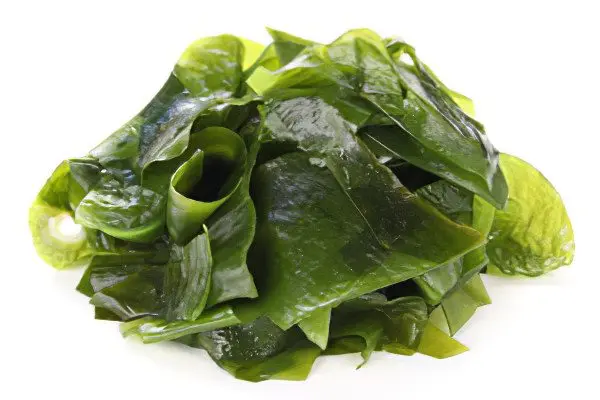Contents

Laminaria, which is known as seaweed, is a real storehouse of vitamins. People from ancient times eat these algae for food, use them as fertilizer. There was a use for kelp in medicine.
Algae are actively used in cosmetology. They not only improve the condition of the skin and fight wrinkles, but also help to cope with cellulite.
Laminaria can be seen in the Atlantic and Pacific Oceans on cobblestones and rocks. This algae is able to form its thickets at a depth of 10–35 meters.
Description and composition of kelp

Laminaria (brown algae) have a thallus body, as well as roots called rhizodes. With their help, the plant is attached to surfaces. The thallus can reach 12 meters in length, it is smooth or wavy. Laminaria on the seabed grows very actively. The average depth at which algae begin to grow is 10 m. Sometimes they settle deeper.
Laminaria contains at least 70 vitamins, minerals, enzymes and proteins. It contains B vitamins, magnesium, calcium, potassium, iron and iodine.
Calories 18 KKal
- Fats:
0,6 g
- Proteins:
1,6 g
- Carbohydrates:
9,6 g
- Water:
81,6 g
- Ash:
6,6 g
- Cellulose:
1,3 g
Vitamins (in 100 g): | Quantity | %RDN |
Vitamin K | 66 mcg | 55% |
Vitamin B9 (folic acid) | 180 mcg | 45% |
Vitamin B12 (cyanocobalamin) | 1 mcg | 33,3% |
Vitamin D (cholecalciferol) | 2,4 mcg (96 IU) | 16% |
Vitamin B5 (pantothenic acid) | 0,64 mg | 12,8% |
Vitamin B2 (riboflavin) | 150-320 mg | 11,8% |
Compared to other marine species, kelp has a greater ability to extract minerals from sea water and therefore accumulate many elements. For example, the content of magnesium is 9-10 times higher, sulfur is 17 times higher, bromine is 13 times higher. In addition, 1 kg of kelp contains as much iodine as it is dissolved in 100 liters of sea water. In general, the amount of iodine in kelp is several thousand times greater than in terrestrial flora. In addition, boron in kelp is 000 times more than in oats, and four to five times more than in potatoes and beets.
Minerals (in 100 g): | Quantity | %RDN |
Iodine | 2500-3600 μg | 2033,3% |
Bor | 225-400 μg | 464,4% |
Bromine | 3400-13000 μg | 410% |
Vanadium | 85-160 μg | 306,3% |
Silicon | 51 mg | 170% |
Cobalt | 15 mcg | 150% |
* Arsenic | 7-15 μg | 91,7% |
* Strontium | 200-700 μg | 56,3% |
Chlorine | 1056 mg | 45,9% |
Magnesium | 121-126 mg | 30,9% |
* Cadmium | 1,4 mcg | 28% |
Sodium | 233-312 mg | 21% |
Hardware | 2,85-3,30 mg | 20,5% |
Lithium | 7,7-31,4 μg | 19,6% |
Calcium | 168-220 mg | 17,6% |
Sulfur | 134 mg | 13,4% |
Copper | 130 mcg | 13% |
Zinc | 1230 mcg | 10,3% |
Full chemical composition ➤
Other important connections:
Phytosterols — 6,62-23,2 mg (27,1% of RDI)
Purine — 5 mg (5% of RDI)
Oxalic acid — 1,5 mg (0,4% of RDI)
Minerals. 30 g of kelp contains 220 mg of calcium. Brown algae are a source of iodine.
Sterile. These substances thin the blood, prevent the formation of blood clots, prevent cholesterol from being deposited in the vessels.
Polysaccharides. Their entry into the body allows you to normalize metabolic processes, stabilize blood sugar levels, regulate the water-salt balance. Polysaccharides from kelp prevent the formation of blood clots.
Niacin. This substance contained in kelp makes the skin healthy, radiant, and helps to get rid of age spots.
Algin. It protects the body from the effects of radiation.
Useful properties of kelp

Laminaria is useful to eat, as it has many healing properties, including:
Saturation of the body with vitamins.
Getting rid of excess weight.
Prevention of diseases of the thyroid and parathyroid glands.
Correction of metabolic processes in the body.
Prevention of constipation.
Normalization of sexual function.
Relief from depression and stress.
Prevention of diabetes.
Prevention of diseases of cardiovascular pathologies, in particular, hypertension and atherosclerosis.
Normalizing the level of cholesterol in the blood.
Treatment of diseases of the joints. Laminaria is useful for people suffering from gout and arthritis.
Prevention of osteoporosis.
Prevention of diffuse toxic goiter.
Improve visual acuity.
Enhance immunity.
Treatment of skin diseases, improvement of the condition of the mucous membranes.
It has been proven that regular use of kelp brings benefits to the human body.
It must be included in the diet, as it has the following properties:
Increasing the strength of blood vessels. This is possible due to iodine salts. They ensure the normal functioning of the thyroid gland. The consumption of kelp allows you to improve the cardiovascular system as a whole.
Reducing the level of cholesterol in the blood and its excretion from the body.
Ridding the body of salts of heavy metals and radionuclides.
Normalization of blood pressure. This is due to the stable work of the cardiovascular system.
Improving the functioning of the digestive system.
Burning body fat. This is possible thanks to fucoxanthins, which convert fat into energy.
Increasing the body’s own defenses. This effect is ensured by the abundance of nutrients in kelp.
Improvement of the thyroid gland, stabilization of the hormonal background.
Tissue regeneration. Any wounds will heal faster if you eat kelp. This is due to the presence of alginic acid in it.
Moisturizing the skin, increasing its elasticity.
Decreased tissue swelling.
Improvement in visual acuity. This is possible due to the fact that algae are rich in iodine salts and beta-carotene.
Contraindications to the use of kelp
Laminaria is contraindicated in people who are allergic to iodine. There is a lot of this element in seaweed. An allergic reaction is manifested by rashes on the skin.
Laminaria is contraindicated in people with diseases such as:
Kidney inflammation.
Acne and furunculosis.
Hemorrhagic diathesis.
Chronic pyoderma.
Multinodular goiter of the thyroid gland, hyperthyroidism.
Intestinal obstruction.
Video: about the benefits of kelp in the program “Live Healthy!”:









